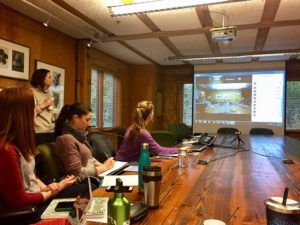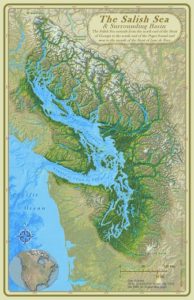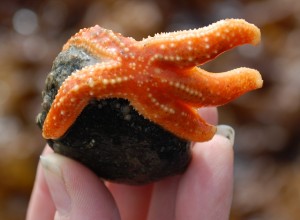Possibly for the first time in history, islanders from the entire length of the Salish Sea met to make conservation connections and discuss ways to champion biodiversity.
The Vashon Nature Center crew loaded into the VNC Science Adventure Lab (AKA: Bianca’s VW van) and headed to Bainbridge Island on March 26 for the Salish Sea Island Biodiverstiy Summit. Not to be thwarted by a canceled Southworth ferry (a quintessentially island problem), the group rerouted through Tacoma and made it to Bainbridge with 20 minutes to spare.

Vashon Nature Center was represented by Bianca Perla, Maria Metler, Kelly Keenan and Kathryn True. Vashon Islander Bruce Haulman was a guest speaker. Christina Doherty, Blair Griffin and Kaitlin Parker hosted us and joined in the conversation representing IslandWood. Brenda Padgham, conservation director of the Bainbridge Island Land Trust, also participated live from the conference room, where we connected with other islanders throughout the Salish Sea via the web. Photo by Christina Doherty
Co-hosted by Vashon Nature Center, CREOi and IslandWood, with an education team that kindly offered technical assistance and space to run the web conference, more than 20 participants representing 30 islands from Harstine in south Puget Sound, to Hornby in Canada’s Gulf Islands joined the conversation, with 20 more who could not make this summit expressing interest in future collaboration.
“In preparing for this summit I was impressed by the interesting and varied projects going on throughout the islands,” Bianca says. “There are some innovative programs from citizen science amphibian monitoring, to eel grass transplanting, to herring restoration efforts, to bulkhead removal. Islands can be very isolated socially and ecologically, but they can also be hotbeds for change, where new techniques and ideas can be tried out on a small and experimental scale. And islanders, perhaps because of their close physical daily connection with the Salish Sea, tend to be natural environmental stewards.”
The summit goals were to:
- Kick-off conversations and connections between island conservation practitioners.
- Explore how islands contribute to Salish Sea biodiversity
- Examine commonalities in research and the challenges involved in accomplishing conservation goals
- Explore further networking ideas to increase effectiveness and benefit island-based organization

We have no comprehensive understanding of how many animals, plants, and fungi are found on islands in the Salish Sea, or how many threatened, endangered, or otherwise sensitive or endemic species are found on these islands. The new island network could lead to a better understanding of island roles in structuring patterns of biodiversity in the Salish Sea. “The unique characteristics that make island biodiversity so special also leave it particularly fragile and vulnerable.” —Convention on Biological Diversity, United Nations. Map by: Stefan Freelan
After a welcome from VNC director Bianca Perla, Bert Webber, professor emeritus of the Huxley College of the Environment at Western Washington University (WWU), shared the boundaries of the Salish Sea, which includes the Strait of Georgia, Strait of Juan de Fuca and all of Puget Sound, and the watersheds that drain into those waters. He explained that the importance of the Salish Sea is magnified by the fact that it is an estuarine ecosystem—and that the 8 million people who live on the mainland surrounding it are equal to islanders in impacting and preserving its health.
Next, Vashon’s own historian, Bruce Haulman, shared thoughts on the uniqueness of human communities on islands in the Salish Sea, and how islands have fewer, broader and unoccupied ecological and social niches, with each island’s community characteristics being governed by ease of access (Is there a bridge? How close to the mainland is the island?). Bruce explained that islands tend to have less diverse human populations then surrounding mainland areas—smaller, less dense populations, and for many islands higher average income levels. In addition, he said that islanders tend to have an environmental ethic more pervasive throughout the entire population compared to people living in mainland areas.
The final presenter was Stefan Freelan, GIS specialist and assistant director of Huxley Spatial Institute at WWU in Bellingham, who shared GIS analysis of island shorelines in the Salish Sea. Stefan counted approximately 1,000 saltwater islands in the Salish Sea; interestingly, two-thirds of them in Canada. In the Salish Sea, 40 percent of the shoreline surrounds islands, and this number reaches 48 percent if you include Vancouver Island—so almost half the sea’s shoreline is island shoreline.
During the last segment of the summit, the group shared thoughts prompted by two brainstorming questions: What are some unique ecological, resource management, or conservation values and challenges that islands have in common? What are some compelling and useful ways that island communities could network to increase the power of conservation work and research?
A pre-summit survey showed a heavy focus on shorelines and environmental stewardship. This is interesting in light of Stefan’s finding that Salish Sea Islands contribute more than half the shoreline of the Salish Sea, and seems to be a shared point of interest where islanders can work together and cause significant change in shoreline habitat for this entire estuarine ecosystem.
During this exchange, we learned of natural history data sets (Andy Lamb—author and marine naturalist and educator—has data from 6,400 SCUBA dives!), and biological assessment and BioBlitz events that could be compiled into a Salish Sea species list that might answer some of our questions about what species are associated with our islands.
We are excited about next steps for this group, which include establishing a directory of island conservation practitioners and researchers and distributing it so that summit participants can network with people across islands doing similar projects or facing similar challenges. We will also set up a network platform or on-line conversation forum so that islanders can stay current on what’s happening throughout the Salish Sea, encouraging partnerships and perhaps even inspiring groups to seek joint-funding for similar projects across multiple islands. We will convene the summit annually to keep ideas and connections flowing.

Why do island matter? “Islands make up 5.3% of Earth’s land area yet maintain an estimated 19% of bird species, 17% of rodents, 17% of flowering plants and 27% of human languages. Species diversity is disproportionately threatened on islands in relation to the islands’ proportion of both global land area and species, with 61% of all extinct species and 37% of all critically endangered species confined to islands. Languages are disproportionately threatened on islands in relation to land area with 11% of extinct languages and 25% of critically endangered languages on islands. Islands are a priority area for integrated conservation efforts because they have 14 times greater density of critically endangered terrestrial species and 6 times greater density of critically endangered languages than continental areas.” —Bernie et al. 2015, Bioscience. Photo by Kelly Keenan
“I believe that islands can play an important leadership role in restoring the Salish Sea so that nature here thrives once again,” Bianca says. “As islanders from far-reaching waters of our shared sea sit down in a virtual room together, maybe for the first time in history, it gives me chills to think about what we might accomplish by putting our minds, hearts, and efforts together.”
If you know of any island conservation or land management groups that might be interested in joining future conversations, please let us know.


Very ExCITing!
Yes!
Hi
Andy Lamb here and the dive total for our dive log data base in the Pacific Northwest is actually about 6,400 with a majority of these in the Salish Sea.
Best Regards, Andy
Thanks Andy!! Will make the edit.
Aquariums, beach naturalist groups, land trusts, Audubon Society chapters, and other conservation groups on the Salish Sea islands and surrounding shoreline all seem like natural partners. Many citizen science groups (COASST for example, and the Washington Aquatic Reserve citizen stewardship committees) would also have overlapping information and interests.
Thanks for the suggestions Rayna. Many were represented!
IslandWoodies were thrilled to see our friends at Vashon Island Nature Center and there is a lot of enthusiasm here for continuing the conversation. Thank you again to the presenters and for the leadership and vision of VNC.
Christina, Naturalist
IslandWood
Thanks Christina! We were thrilled to partner with IslandWood on this!
Bottom half of a new fawn discovered in the middle of a path in our stewardship forest…remaining body missing.
We live on 25457 86th Pl SW ( off Dockton Rd….between 248th and Dockton Park)